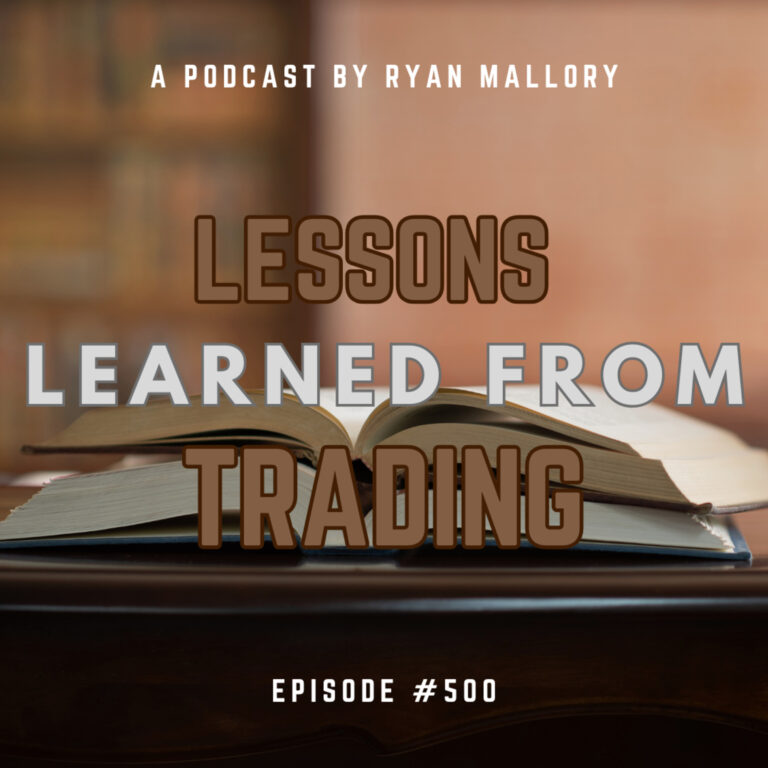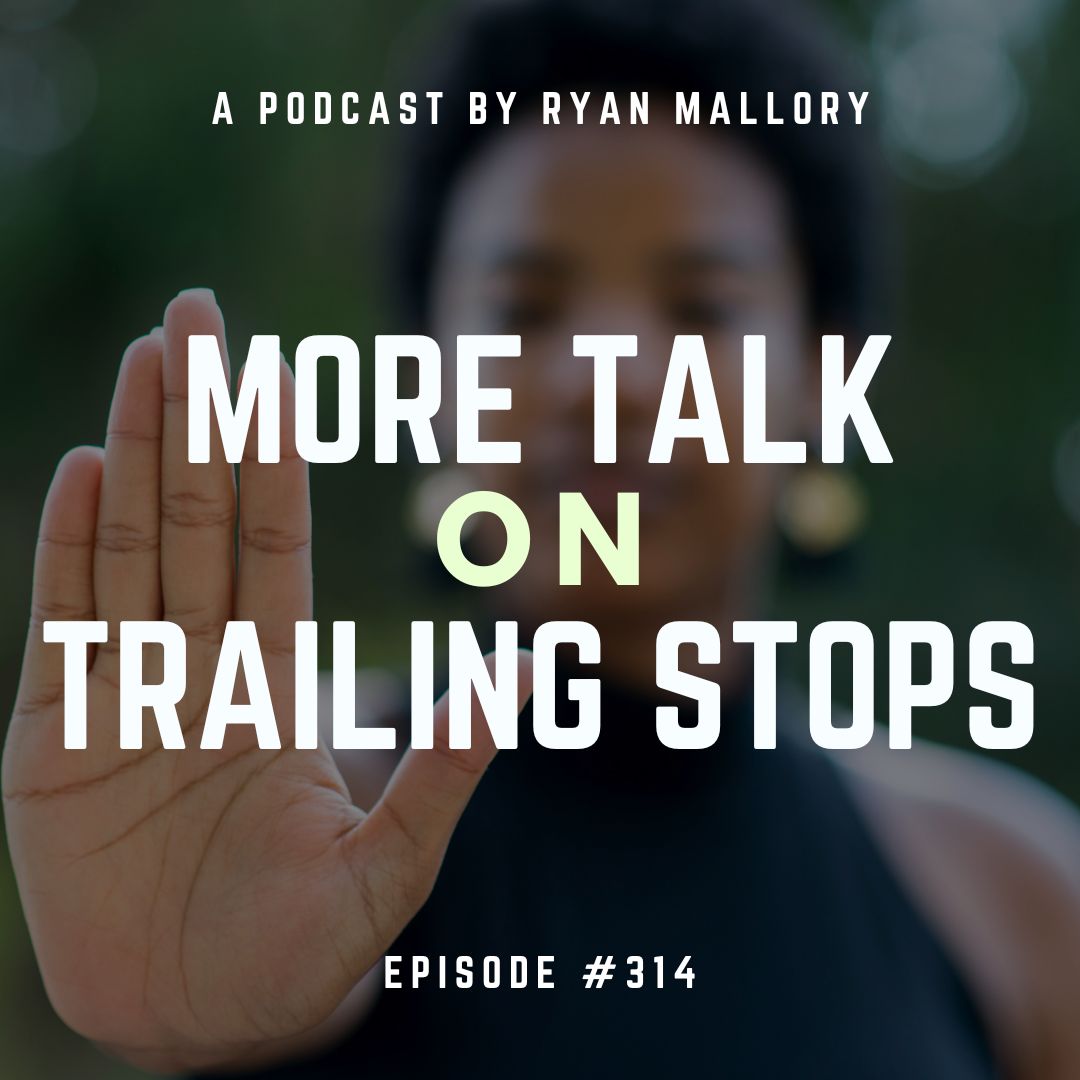Episode Overview
Let’s talk more about trailing stops with swing trading because the questions keep coming in on these and I think it is important to continue talking about as long as you all have questions about them.
Available on: Apple Podcasts | Spotify | Amazon | YouTube
Episode Highlights & Timestamps
- [0:07] Introduction
Ryan opens the podcast by diving into the topic of trailing stop losses and the questions he’s been receiving from listeners about them. - [1:28] The Listener’s Question
A retired listener, “The Floridian,” explains his background and asks whether trailing stops are a good replacement for fixed stop losses. - [3:05] The Risk of Trailing Stops
Ryan highlights how trailing stops don’t account for key support levels and can lead to premature exits during normal volatility. - [6:51] The Dangers of Good-Til-Canceled Orders
Ryan explains how good-til-canceled trailing stops can be vulnerable to early morning volatility and technical anomalies. - [9:59] Final Thoughts on Stop Loss Strategy
Ryan wraps up the discussion by clarifying the difference between trailing, mental, and manual stop losses, emphasizing why he prefers manually adjusted hard stops for better risk management and decision-making control.
Key Takeaways from This Episode:
- Trailing stops lack nuance: They don’t account for support levels and can trigger exits on normal market volatility.
- Manual stops offer better discretion: Manually adjusted hard stops allow for better risk control and market context.
- Avoid GTC trailing stops: Early market open can cause wild price prints and trigger stops erroneously.
- Mental stops are risky: While they avoid accidental triggers, traders often fail to execute them under pressure.
- Market timing matters: Knowing when to avoid trades, like during the first few minutes of market open, can save you from unnecessary losses.
Resources & Links Mentioned:
- Swing Trading the Stock Market – Daily market analysis, trade setups, and insights by Ryan Mallory.
- Join the SharePlanner Trading Block – Get real-time trade alerts and community support.

Take the Next Step:
✅ Stay Connected: Subscribe to Ryan’s newsletter to get free access to Ryan’s Swing Trading Resource Library, along with receiving actionable swing trading strategies and risk management tips delivered straight to your inbox.
📈 Level Up Your Trading: Ready for structured training? Enroll in Ryan’s Swing Trading Mastery Course, The Self-Made Trader, and get the complete trading course, from the foundational elements of trading to advanced setups and profitable strategies.
📲 Join the Trading Community: Sign up for SharePlanner’s Trading Block to become part of Ryan’s swing-trading community, which includes all of Ryan’s real-time swing trades and live market analysis.
Full Episode Transcript
Click here to read the full transcript
0:07
Hey, I’m Ryan Mallory and this is my swing trading the stock market podcast. I’m here to teach you how to trade in a complex ever-changing, world of Finance, learn what it means to trade, profitably and consistently managing risk, avoiding the pitfalls of trading. And most importantly, to let those winners run wild, you can succeed at the stock market and I’m ready to show you how, hey, everybody, this is Ryan Mallory with swing trading the stock market and today’s episode We’re gonna look at digging a little bit more into trailing stops.
0:40
Now, I’ve done a number of podcast episodes on trailing stops, but you guys keep coming at me with some questions and I want to answer them. So my theory is always been when I get an email on something, there’s probably you know, a hundred thousand people out there that are probably asking the same question. So it behooves me really to try to address these questions as they come in because when I see the same kinds of questions coming up over and over again, either one, I’m not explaining it.
1:02
Good enough or two. I need to devote more time. I came to discuss in this particular aspect of trading. So that’s what I’m doing here today. And this guy here, we’re going to call him the Floridian, because that’s what he asks to be caught. He writes. Hi Ryan, I’ve really enjoyed your podcast and common-sense approach to swing trading over the last month or so I have about half of my liquid assets with an advisor in the other half and real estate properties, are have recently, retired and liquidated, my real estate holding.
1:28
So I would like to develop my trading skills to the point to where I can be comfortable with trading increased portions of my portfolio. I’ve been swing trading different portfolio. Strategies part time with limited risk position. Since May of twenty twenty-two, with modest net, gains and Lessons Learned.
1:44
I like your risk management philosophy very much and have been using trailing, stop losses on trades that I have made at times. I have broken my own rules, but I know I can follow your advice and stick to the rules of whatever. Setups I decide on, I noticed you also use fixed stop losses on trades and adjust them as you get in the money.
2:00
My question is, whether you have tried trailing stop losses and whether you recommend them in the place of Next stop losses. Thank you, the Floridian. So yeah, actually talked about this in a previous episode I think was like last week probably, but I don’t mind digging more into it because I think it is a very important aspect of trading.
2:17
I know a lot of people like using trailing stop losses that takes the emotional Edge out of it. And that’s very true because you don’t have to think about raising the stop losses, it’s automatically doing it for you. And like I said, before, a trailing stop loss is better than no stop loss. At least there’s some element of risk management there.
2:33
But I’m going to tell you the reasons why I don’t like trailing stop losses. And what am I drinking? While I’m doing this podcast, I have got here. Ragtime Rye bottled in bond from the New York Distilling Company. Its 50% alcohol, is that gives it a hundred proof.
2:49
It’s a straight rye whiskey. So going away from the Irish Whiskey’s, finally was formed that bad actually going to this one here. So I’ll be drinking. And while I’m doing this podcast episode, I’ll let you know, my thoughts at the end. So as I said trailing stops, they’re better than those stops at all. They’re better than using mental.
3:05
Because mental stops will get you in trouble, but I’d actually using a stop loss. But you want to remember this about drilling stops trailing stops are based off of the highs attained on the trade that you are in. Not like the 52-week highs, or the all-time highs, the highs that you’ve reached in a trade.
3:21
So if you get into a trade and you have a 5% stop loss on it and it goes up to 110, it’s going to be or the stop loss will be 5 percent lower than 110, or if it let’s say just to make things easy, it goes up to 200. Applause would be at 190.
3:37
But with that being said, what it’s not based on is key support levels. So when the stop loss is moving up, because the stock is moving higher, you have the potential to be above key support levels. So, you have, let’s say, a key support level at $100, a share and your stock is going higher and higher and higher.
3:54
And then all of a sudden, you have a trailing stop loss at 102. That’s probably not the best place to be. At where you have a stoploss just above key support level, because you only want to get out of the stock. It’s basically turned against you. When it says, okay, it’s time to get out of this trade because clearly, the trade is not working anymore, but if you get out before, support is tested, you might be erroneously stopped out for no reason at all.
4:18
Perfect example of this was just the other day. We have fed chairman talking and let’s say, you were long on spy. Well, you had the FED chairman talking, he was taking questions from some interviewing guy and the market initially liked what he said, Mark went way up, and then it came way back down and then it went right back up again and I think every one of these swings one of them, I think the initial one was like two percent. Then it pulled back two percent and then it’s like, took off like three percent was crazy. It was just a monstrous move.
4:35
And so if you had these price swings and your trailing, stop was adjusting to the initial price swing. Well, then on the way back down, you might have gotten stopped out and then you saw it all of a sudden turn right back around and go back up to the highs of the day and beyond. And so, that’s what trailing stop losses can do because it takes really any discretion out of it. And for some of you guys might like, hey I don’t want to have to think about this stuff.
5:07
I don’t want to have to figure this out. I just want the market to do it for you. Well trailing stop losses it’ll do it for you but it’s not necessarily the best way for it to do it for you. I think human logic and I think humans being able to look at a chart and becoming good at looking at a chart and say, hey, this is where key support is. This is where I need to put my stop loss below, but the trailing stop losses won’t do that for you.
5:26
And so, in the example that I just gave where the market was doing these wild price swings, you might not even have been in the Spy ETF, you might have been in something else, maybe Bed Bath & Beyond or something that has really crazy price swings. Or you know, some stupid Wall Street bet stock that could’ve been wildly affected by not that you should be in these.
5:44
Let’s say that you are and it has like a five or a ten percent swing. As a result of it in each direction, then you get stopped out that kind of sucks or it can be a stock with a beta of like 1.5 in its wings three or four percent, that would be pretty significant from an intraday basis and you could easily be stopped out of that, only for you to see it take off the rest of the day and into the following day.
6:00
And the reason why that wouldn’t necessarily happen as much if you’re using manual stop losses which is what I like to use, and they’re definitely not mental stop losses is because I can see these price swings but I don’t necessarily have to react to it by adjusting my stop loss.
6:16
But with the trailing stop loss, if it’s hitting a new high on the trade, it’s going to adjust it for you and when it comes back down, there’s a very good chance it will erroneously stop you out. And in the case was yesterday, let’s say you had a seven dollar stop loss on spy, you would have been stopped out of those price swings, and if you don’t know which day I’m talking about here, just look at it.
6:35
February 7th 2023. You will see that there was a massive, massive intraday price swings. You won’t see it on the daily but you will see it on the intraday charts. Another reason why I’m not a fan of trailing stop loss is because most of them are good to cancel. And I’ll tell you in a little bit why I don’t like good to cancel.
6:51
But what that does for you though, is it exposes you to some crazy price action in the first three minutes of trading. I don’t like trading anything new in the first 30 minutes of trading, but what you have with a trailing stop loss is, you can have some very wild price swings particularly right when the stock market opens.
7:07
And so you could get this crazy print at the very beginning and the market comes right back down and stops you out. It happens all the time or you get these like phantom prints that you don’t even see. But for whatever reason, the stock thinks it had reached that high because there was a bid price for a split second at a very high level, you might not have even seen, and it comes right back down to reality, and all of a sudden you’re stopped out.
7:24
That first, I would say, first two minutes of trading can be really, really wonky, especially as stocks are starting to open during regular trading hours. I mean, just look at what happened. I think it was a couple weeks ago where the NYSE had to halt a whole bunch of stocks because it was printing these like wild wild price prints like 10–15 percent above previous day and then it would drop like 10 or 15 percent below the previous day’s close.
7:52
You can’t tell me that a lot of people weren’t getting triggered on their stop losses as a result of using trailing stop losses. And we all know that was basically a mechanical error on the NYSE. But I can’t see where they necessarily refunded people’s money or they broke the trades.
8:08
Sounds like to me that people were just kind of stuck with those stop losses being triggered, and again, that happened right when the market opened. Yes, I will put my stop loss on, you know, a minute or two into each trading session and I never use good to cancel because of those. The very reason that I just explained those first couple minutes of trading.
8:27
And they can be very, very wonky. They’re crazy. You get weird prints. I’ve been stopped out erroneously and I couldn’t even figure out why I was stopped out because I used good to cancel stop losses. So each morning I put my stop loss on, I do not carry them overnight, reenter them every single day and while I said they’re better than using mental stops because half the time people who use mental stops don’t actually follow their stops.
8:49
There are other ways actually worse. Yeah worse because if you get stopped out erroneously that’s kind of crappy. Mental stops you won’t get stopped out of erroneously because you’re not even putting in a stop loss until it gets real close or until that mental price barrier triggers. And so, ultimately, that’s why I use the manual.
9:06
Stop loss. If they allow you and they’re hard stops, by the way, they’re not mental. Hard, manual stops allow you to see through the noise that can happen from a day-to-day basis. Just like, with the debacle with the New York Stock Exchange the other day when they were opening up, just like with the crazy price action that you can see on the first 30 minutes of trading, if you’re trailing stop loss is reacting and adjusting to these crazy price moves,
9:27
You may be getting stopped out far earlier than what you would have wanted to be stopped out and at a loss. And by the way, before I forget make sure to check out swingtradingthestockmarket.com. This is going to be the Patreon website that goes along with this podcast episode. And with it, you’re going to get all my stock market research each and every day.
9:44
That’s going to include watch lists, my master watchlist updates each week, the watch list for each day. Also giving you big tech updates on all the major tech stocks and market updates throughout the week. So check that out at swingtradingthestockmarket.com.
9:59
Same name as this podcast. And the Floridian here, he talks about and calls these manual stop losses that I use fixed stop losses. They’re not necessarily fixed. I adjust them all the time as a stock increases in value. I’ll try to find additional layers of support that I want to put my stop loss at as it increases in value, also book profits along the way which also helps to reduce risk.
10:16
And so, to wrap this up, what am I talking about here? One, trailing stops they are not my favorite thing to use. I don’t think that they’re as good as using hard manual stops. In some ways, they’re better than mental stops.
10:33
Some ways, they’re worse. I mean overall, I would say that they’re better than using a mental stop, but there’s some aspects of a mental stop that doesn’t subject you to the kind of crazy price action that a trailing stop loss will do. Because if you have a major price swing to the upside and it quickly comes right back down again,
10:50
You risk getting stopped out very quickly and sometimes even for a loss. And to the Floridian who’s been trading since May 2022 with modest net gains that’s impressive. It’s impressive because you went through a very bearish market, very difficult market. You came out with some gains. That’s awesome.
11:06
So keep it up. You’ve got a lot to learn. You’ve really only experienced a bear market with a lot of chop. You haven’t really experienced a true bull market and you’ve got to still experience that because that’s a completely different environment of trading than what you experienced for most of 2022.
11:22
And as for this bourbon that I’ve been drinking the whole time, not bad. It’s actually got a pretty good kick. I wouldn’t say it’s overly flavorful. It’s very dry. It’s got some vanilla flavor, maybe some like leather and mint. I’m gonna give it a 7.6. I don’t it’s one of the better whiskey ryes that I’ve tried in a while.
11:38
Not bad at all. 7.6 Ragtime Rye. 50% alcohol, 100 proof. I love that, it’s 100 proof. Not bad at all. And if you enjoyed this podcast episode, I would encourage you to leave me a five-star review on whatever platform that you’re listening to. Come on, guys, do it for me. I appreciate it when you guys do that, and make sure to keep sending me your emails.
11:56
ryan@shareplanner.com is where you can reach me. I do read them and I try to pretty much put every one of these things into their own episode. So make sure to keep sending them to me and be sure to sign up for swingtradingthestockmarket.com. Won’t be sorry.
12:13
Thanks for listening to my podcast. Swing Trading the Stock Market. I’d like to encourage you to join me in the SharePlanner Trading Block, where I navigate the stock market each day with traders from around the world. With your membership, you will get a 7-day trial and access to my trading room including alerts via text, email, and WhatsApp.
12:29
So go ahead, sign up by going to SharePlanner.com/tradingblock that’s www.shareplanner.com/trading-block. And follow me on SharePlanner’s Twitter, Instagram, and Facebook, where I provide unique market and trading information every day. If you have any questions, please feel free to email me at Ryan@SharePlanner.com. All the best to you and I look forward to trading with you soon.
Enjoy this episode? Please leave a 5-star review and share your feedback! It helps others find the podcast and enables Ryan to produce more content that benefits the trading community.
Have a question or story to share? Email Ryan and your experience could be featured in an upcoming episode!
Become part of the Trading Block and get my trades, and learn how I manage them for consistent profits. With your subscription you will get my real-time trade setups via Discord and email, as well as become part of an incredibly helpful and knowledgeable community of traders to grow and learn with. If you’re not sure it is for you, don’t worry, because you get a Free 7-Day Trial. So Sign Up Today!

Welcome to Swing Trading the Stock Market Podcast!
I want you to become a better trader, and you know what? You absolutely can!
Commit these three rules to memory and to your trading:
#1: Manage the RISK ALWAYS!
#2: Keep the Losses Small
#3: Do #1 & #2 and the profits will take care of themselves.
That’s right, successful swing-trading is about managing the risk, and with Swing Trading the Stock Market podcast, I encourage you to email me (ryan@shareplanner.com) your questions, and there’s a good chance I’ll make a future podcast out of your stock market related question.
In today's episode, at episode 500, I am diving into the lessons learned from trading over the last 100 episodes, because as traders we are evolving and always attempting to improve our skillset. So here is to episode 500, and to another 500 episodes of learning and developing as swing traders in the stock market!
Be sure to check out my Swing-Trading offering through SharePlanner that goes hand-in-hand with my podcast, offering all of the research, charts and technical analysis on the stock market and individual stocks, not to mention my personal watch-lists, reviews and regular updates on the most popular stocks, including the all-important big tech stocks. Check it out now at: https://www.shareplanner.com/premium-plans
📈 START SWING-TRADING WITH ME! 📈
Click here to subscribe: https://shareplanner.com/tradingblock
— — — — — — — — —
💻 STOCK MARKET TRAINING COURSES 💻
Click here for all of my training courses: https://www.shareplanner.com/trading-academy
– The A-Z of the Self-Made Trader –https://www.shareplanner.com/the-a-z-of-the-self-made-trader
– The Winning Watch-List — https://www.shareplanner.com/winning-watchlist
– Patterns to Profits — https://www.shareplanner.com/patterns-to-profits
– Get 1-on-1 Coaching — https://www.shareplanner.com/coaching
— — — — — — — — —
❤️ SUBSCRIBE TO MY YOUTUBE CHANNEL 📺
Click here to subscribe: https://www.youtube.com/shareplanner?sub_confirmation=1
🎧 LISTEN TO MY PODCAST 🎵
Click here to listen to my podcast: https://open.spotify.com/show/5Nn7MhTB9HJSyQ0C6bMKXI
— — — — — — — — —
💰 FREE RESOURCES 💰
— — — — — — — — —
🛠 TOOLS OF THE TRADE 🛠
Software I use (TC2000): https://bit.ly/2HBdnBm
— — — — — — — — —
📱 FOLLOW SHAREPLANNER ON SOCIAL MEDIA 📱
*Disclaimer: Ryan Mallory is not a financial adviser and this podcast is for entertainment purposes only. Consult your financial adviser before making any decisions.





